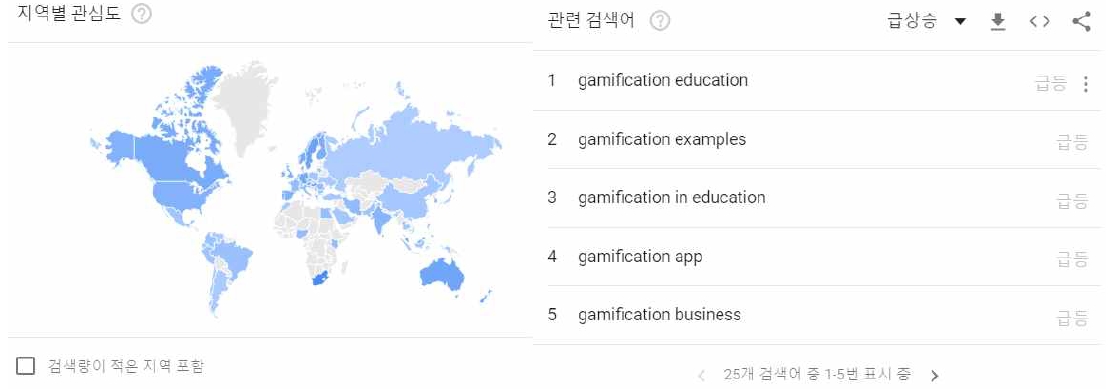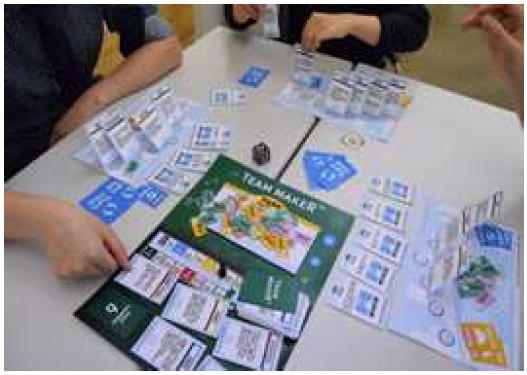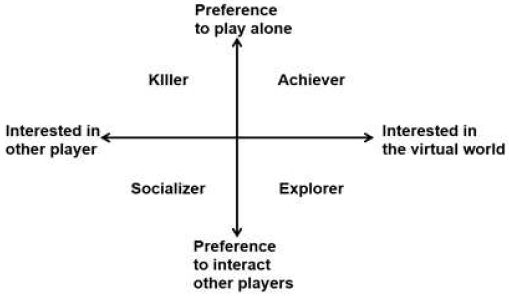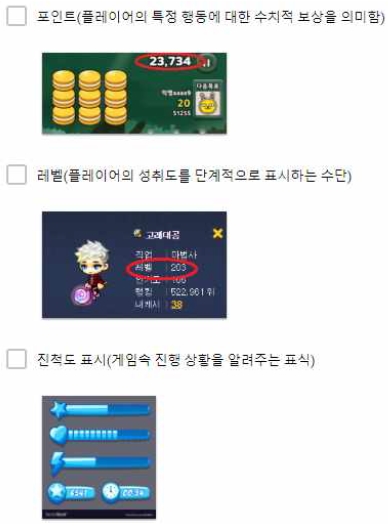
An Analysis of Game Mechanics Preference among Bartle’s Four Player Types
Copyright ⓒ 2019 The Digital Contents Society
This is an Open Access article distributed under the terms of the Creative Commons Attribution Non-CommercialLicense(http://creativecommons.org/licenses/by-nc/3.0/) which permits unrestricted non-commercial use, distribution, and reproduction in any medium, provided the original work is properly cited.

Abstract
Gamification in education can be used by an instructor in the field of educational field. An instructor can face difficulties with game mechanics with regard to player types while designing gamified content. This study aims to determine the preferred game mechanics for each bartle’s player types to design educational gamification. For the analysis, an online survey developed based on previous studies we applied. A total of 134 people participated in this survey. Basic statistics and correlation (Pearson’s r & Kendall's τ) analyses were conducted to examine online responses. The results of the correlation analysis showed no difference or specific patterns in the game mechanics among different player types. However, this study derived semantic differences between killers and other types of players by the relative correlation effect size. We suggest the use of appropriate game mechanics for each player type to academic researchers and industrial developers to design gamified learning contents.
초록
교육 게이미피케이션은 교육 분야에서 활동중인 교수자들이 사용 가능한 방법이다. 교수자는 교육 게이미피케이션을 설계할 때, 학습자의 플레이어 유형에 따른 게임 메커닉스 사용에 대한 어려움에 직면한다. 본 연구는 바틀의 플레이어 유형에 따른 선호 게임 메커닉스를 분석하는 것이 목적이다. 연구 진행을 위해 선행연구를 참고하여 온라인 설문도구를 개발했다. 총 134명이 자발적으로 설문에 참여했다. 결과분석을 위해 기본 통계분석과 상관관계 분석(피어슨, 켄달)을 실시했다. 연구결과, 플레이어 타입 간 선호 게임 메커닉스의 차이나 특정 패턴은 없었다. 그러나, 킬러 유형과 다른 유형 간에 상관계수를 통한 의미적 차이를 도출했다. 연구결과를 바탕으로 학술적 관점과 산업적 관점에서 게이미피케이션을 적용한 학습 콘텐츠 개발에 필요한 적절한 게임 메커닉스 사용 방안을 제언한다.
Keywords:
Gamification, Game Mechanics, 4F Process, Barte’s Player types, Gamification Design키워드:
게이미피케이션, 게임 메커닉스, 4F 프로세스, 바틀의 플레이어 유형, 게이미피케이션 설계Ⅰ. INTRODUCTION
Gamification is a design technical approach that applies game elements including points, badges, and levels to non-game contexts such as management, education, training, and health care. Gamification enhances a user’s motivation and facilitates collaboration and participation[1, 2]. Since the concept of gamification was defined, various application fields have applied gamified approaches. In recent years, various studies related to gamification have been performed and the field of gamification has received attention on a global scale, as shown in Fig. 1. In particular, education is a field wherein gamified approaches have garnered interest, as shown in Fig. 2. In the corporate sector, gamification has been applied to improve mental health care of employees. Lerch et al.[3] studied the gamification of health care and mental needs based on the self-determination theory. According to Lerch et al.[3], gamified fitness applications satisfied employees’ enjoyment and basic mental needs, and it improved their competence in corporate life.

Keyword Comparison among Gamification(Blue), Game-Based Learning(Yellow) and Serious Games(Red) from a Google Trend Search from Feb 2011 to Oct 2018.
Gamification also helps manage cautions or risks of an enterprise. Bajdor and Dragolea[4] analyzed the main element of risk management, which are sociality, technology, competition, internal factors, political, and economic elements. Bajdor and Dragolea derived 12 ideas to deal with enterprise risks and cautions through gamification, game mechanics, board games, and a slot machine algorithm. Thom et al.[5] applied gamification to an in-house social network service (SNS) to improve productivity. The study demonstrated that employees’ in-house online activity increased by a factor of approximately 2.5 owing to the gamification of the SNS. A popular application of gamification is the fun theory, which has solved a social problem such as vehicle over-speed and recycling. The speed lottery is a case of the fun theory being used to solve the problem of vehicular overspeeding. Speed lottery decreased the average vehicle speed by 22% [6]. Christmann et al.[7] attempted to improve stress related conditions using a gamified application that effectively supports mental health care and behavior change.
In the field of education, gamification brings new value for learners and instructors. Gamification in education motivates the leader and facilitates learner engagement. Milier[8] suggested that gamification is an effective tool for new learners. Giang[9] demonstrated that the use of game mechanics improves the ability to learn new skills by 40%. According to Dicheva et al.[10], gamification applied in the education field is primarily a combination of learning, a massive open online course (MOOC), e-learning, and online support for courses. According to Huang and Soman[11], gamification decreases the negative emotions from experienced in traditional education.
Gamification deliveries a gameful experience to the learner. Gameful experiences are popular amongst learners and aids in achieving the learning goal in a classroom. Thus, a gamified approach for instructors help achieve the classroom goals.
Figure. 3 shows a “Team Maker” activity, in which the goal is to train the learners on Situational Leadership Theory II (SL2), developed by Blanchard et al.[12]. According to SL II, team members can be classified into four categories according to their social and job-processing abilities. The team leader should match to each team member. “Team Maker” consists of components such as team-member cards, team-leader cards, and virtual money. The team leader (player) recruits team members who fit the team leader’s leadership style as per SL II. When a team leader recruits a team member, they negotiate with other players through an auction.
Figure. 4 shows a game of “The Lost City,” in which the goal is to understand the use of a financial product. The Lost City is an example of location-based gamification. Each player receives a tablet PC to be able to play. In the game, the player creates virtual resources according to game scenarios. To the win the game, a player invests in the facility for resource mining in the game and accumulate the largest amount of virtual currency by trading with other players. The Lost City can provide the experience of real financial products such as mortgages and loans provided by non-player characters (NPC) in the game. Kang[13] verified the educational effect of The Lost City through a qualitative study using multisided surveys with players, their parents, and teachers. According to the study, a gamified learning system based on the real world is effective for learner-centered education. Furthermore, a gamified approach facilitates interaction between players and the learning environment.
As gamification created new values in various fields, studies on the development of effective gamification methodologies begun to be published. Mora et al.[14] conducted an empirical study on gamification development methodology that was examined using data published between 2011 and 2015. According to the study, the common elements of the published methodologies are as follows: economic (about funding and operating), logic (about rules and setting of game mechanics), measure (about performance indicators), psychology (about motivating and social activities in the gamification), interaction (about UX/UI and technology-based settings).
Bockle et al.[15] published the following four criteria for gamification methodology development: the purpose of adaptivity (about user/participants analysis), adaptivity criteria (about player types, goal setting, and content level), adaptive interventions (about UX/UI and guidelines for gamification play), adaptive game mechanics and dynamics (about game mechanics and dynamics).
Kim et al.[6] suggested the 4F process for the gamification design. The steps in the 4F process in chronological order are Figure out, Focus, Fun Design, and Finalize (Fig. 5). Figure out is the first step and involves analyzing the target program or content and the identify the participants. In the Focus step, the play time, play type, and fun experience are set. Play type is further classified as software, hardware, or big game/alternative reality game. Fun experience is based on the playful experience (PLEX) framework designed by Arrasvuori et al.[16]. In the fun design step, the designer makes the story considering the suggested criteria and sets the game mechanics, rule, and winning/losing elements ratio (players’ knowledge/skill, experience, and luck). The finalize step is prototyping and pretesting with pre-testers who voluntarily participate.
Using gamification design methodology, it is possible to clearly deliver the goal set by the designer. Gamification in learning also works in a similar manner. For effective learning, gamification should be applied to educational content as well. However, gamification designers face difficulties while setting game mechanics and rules. Game mechanics is a field requiring specialized expertise because generalized formulae or criteria do not exist, and continuous analysis must be performed for gamification design.
Game mechanics should be used by the attributes of a targeted player. A designer analyzes the target player’s characteristics and their player types analyze at the same time. However, each player type brings forth different needs. Thus, this study analyzes the use of game mechanics in depth with the aim finding the preferred game mechanics according to player types. In order to conduct a systematic study, the following three research questions (RQ) are set.
RQ 1: What are the game mechanics that each player type prefers? RQ 2: Is there a specific pattern or differences in the game mechanics among player types?RQ 3: How should a designer use the findings of this study while developing educational gamification?
Ⅱ. BACKGROUND
In this study, the survey of Bartle’s player types[17] is based on Kim’s study[19] and the game mechanics survey was developed based on Kim et al.[6]’s game mechanics table. Eighteen game mechanics categories from those proposed by Kim et at.[6] were applied. This study excludes the questionnaire on game mechanics, which is difficult for a person without academic knowledge on game mechanics to understand. R studio ver. 1.0.143 psych package and Microsoft Excel 2016 were used for analysis.
Bartle[17] classified four player types based on multi user dungeon (MUD) players and derived four features (Fig. 6). He categorized them from the perspectives of player interest in the game (x-axis)—players interested in other players or virtual worlds such as quest, items, and other achievements. Another perspective is the way of player’s actions in the game (y-axis). Players may prefer to play alone or to interact with other players.
2-1 Player Types
The four player types classified by Bartle[17] are as follows.: Achievers prefer solo play and more interested in the virtual world than the other players. Achievers want to upgrade their abilities such as skill and knowledge, and are proud of their achievements in the game. Explorers are interested in the virtual world and prefer to explore the game world and complete quests or missions. Socializers prefer to interact with others. Killers are pleased when there is a negative impact on other players. Killers are interested to kill/eliminate other players; however, killers also prefer solo play. Hamari & Tuunanen[19] studied about published player types. According to the Hamari & Tuunanen, based on previous studies related to the player type, it is possible to conceptually meta-synthesize seven concepts based on the psychographic basis and behavioral basis. Hamari & Tuunanen suggested the conceptual type as follows: Gaming intensity and skill, Achievement, Exploration, Sociability, Domination, Immersion, and In-game demographics. Tondello et al.[20] statistically developed six player types based on people’s intrinsic and extrinsic motivation and personality as follows: Philanthropists, Socialisers, Free Spirits, Achievers, Players, and Disruptors. Nacke et al.[21] attempted to categorize players statistically based on brain science. Nacke et al. developed player types based on brain action responses and suggested the following seven player types: Seeker, Survivor, Daredevil, Mastermind, Conqueror, Socialser, and Achiever.
2-2 Game Mechanics
Sicart[22] defined game mechanics as “Game mechanics are methods invoked by agents, designed for interaction with the game state.” “Methods invoked by agents” is a concept that formalizes the use of terminology taken from the object oriented programming paradigm. Game mechanics provide feedback about a player’s behavior pattern or results in the game. Dicheva et al.[10] meta-analyzed gamification in education from 2011 to 2014.
In his study, the primarily used game mechanics involved points, badges, level, leaderboard, virtual goods, and avatars. Werbach & Hunter[23] defined Point, Badge, and Level (PBL) as a system by bundling points, badges, and levels as they were frequently used in game mechanics. In addition, they included avatar, achievement, badge, boss fight, collection, combat, content unlocking, gifting, leaderboard, level, and points into game mechanics. Arnab et al.[24] defined game mechanics for education through an empirical study. The study classified game mechanics into two perspectives, namely abstract interface (pedagogical/theoretical components) and concrete interface (game design components).
The abstract game mechanics consisted of fun, challenge, behavioral momentum, rewards/penalties, pavlovian interactions, urgent optimism, communal discovery, strategy/planning, story, cooperation, pareto optimal, feedback, protégé effects, mini-games, design/editing, realism, ownership, role play, virality, cascading information, collaboration, and competition. The concrete game mechanics consisted of cut-scenes, action points, levels, tokens, question and answers, game turns, selecting/collecting, resource management, capture/eliminate, quick feedback, goods/information, time pressure, tutorial, tiles/grids, infinite gameplay, appointment, movement, assessment, status, and simulated/response. Park & Kim[25] attempted to statistically find the optimized number of game mechanics use using a Markov chain algorithm and 875 of collected gamification cases; they asserted that there are difficulties when a novice to gamification applies game mechanics and this problem must be resolved for the effective gamification design. According to the Park and Kim[25], the optimized number of game mechanics for effective gamification is 6−9. Kim et al.[6] summarized previous studies related to game mechanics and proposed 25 components of game mechanics as shown in Table 1.
Ⅲ. METHOD AND RESULT
3-1 Survey Development
The game mechanics applied in this study are as shown in Table 2. The survey was implemented using a Google Docs online form. The questionnaire on player types is based on Kim’s[6] 18 questionnaire items. The game mechanics questionnaire items designed that displayed the screenshot about actual game play and asked it was preferred or not (fig. 7).
3-2 Result
Table 3 shows the results of demographics like gender, age, and player types. Eighty-seven males (65%) and 47 females (35%) participated in the survey. Participants in the age group of twenties accounted for a large proportion among the age groups.
Table 3 shows game mechanics distribution of all answers and each player types. According to the results, the order of preference for all player types are as follows: level, quest (mission), point, badge, virtual goods, competition, avatar, virtual money, unlocking, progress, lottery (luck), leaderboard, real goods, scaffolding, social network, co-discovery, authority, and countdown. The preference of game mechanics according to player types are as follows: Achievers preferred the mechanics in the order of quest (mission), level, virtual goods, point, badge, competition, progression, unlocking, avatar, leaderboard, lottery (luck), real goods, virtual money, scaffolding, social network, authority, co-discovery, and countdown. The order of preference of the explorers was level, badge, quest (mission), point, avatar, competition, virtual money, leaderboard, virtual goods, unlocking, lottery (luck), progression, co-discovery, scaffolding, real goods, social network, authority, and countdown. The order of preference of the socializer was quest (mission), level, point, badge, virtual goods, virtual money, avatar, unlocking, progression, competition, real goods, lotter (luck), leaderboard, scaffolding, authority, social network, co-discovery, and countdown. The order of preference of the killer was competition, lottery (luck), level, quest (mission), point, virtual money, avatar, progression, unlocking, countdown, virtual goods, badge, leaderboard, real goods, scaffolding, authority, co-discovery, and social network.
test was conducted to check the independence of game mechanics preference among player types before correlation analysis.test means that the preference of game mechanics among player types are independent without affecting each other.
A correlation analysis was applied to analyze the results. It is also possible to check the directions of the game mechanics. Tables 4 show the results of the correlation analysis Through correlation analysis, the difference in the preferred game mechanics among player types is confirmed. This study found the difference of preferred game mechanics among player types through the correlation analysis. The correlation analysis was performed using both Pearson’s r (parametric) and Kendall’s τ (non-parametric) methods to check the statistical significance[26, 27]. According to Tondello et al. [20], the criteria of Pearson’s r and Kendall’s τ tests are as follows. Small effect: τ = .20 ≈ r = .30, medium effect: τ = .34 ≈ r = .50, large effect: τ = .50 ≈ r = .70. There is a statistically large correlation among each player types. The achiever and other player types are significantly correlated with explorer (r = .81, τ= .66, p < .001), socializer (r = .91, τ = .75, p < .001) and killer (r = .58, τ = .47, p < .01). The explorer and other player types are significantly correlated with the socializer (r = .87, τ = .73, p < .01). The socializer and killer are also significantly (p < .05) correlated with each other (r = .50 and τ = .47).
Ⅳ. DISCUSSION
4-1 Results Interpretation
The results of this study obtained using research questions set by a systematic process are summarized in Table 5. According to the results, there is the preferred game mechanics among each player types. The result of this study is similar to those of previous studies such as Dicheva et al.[10]. In the study, game mechanics that consisted of badges, leaderboard, points, levels, virtual goods, and avatars were found to be preferred in the gamification in education.
Furthermore, the results of this study are similar to those of Kocadere and Caglar [28], who conducted a qualitative study to find the preferred game mechanics among Bartle’s player types. In Kocadere and Caglar’s study, achievers preferred leaderboard, achievement, point, and level. Explorers preferred level, badge, achievement, and story. Socializers preferred story, badge, achievement, team, and gifting. Killers preferred level, leaderboard, and point. The results of Kocadere and Caglar’s study are summarized as quest (mission), progression, and rewards of virtual goods, virtual money. The results of this study are similar to the Kocadere and Caglar’s study with semantic differences between killer and other types. The correlation results of this study are interpreted as follows. There is statistically no specific pattern or differences. However, semantic differences have been interpreted herein. There are no relative differences in the effect size of the correlation analysis among achievers, explorers, and socializers. Between killer and other player types, there is relatively a large difference in the effect size of the correlation coefficient. The effect size of the correlation coefficient among achievers, explorers, and socializers was decreased by 0.06 to 0.1 (Pearson’s r) and 0.02 to 0.09 (Kendall’s τ), while those of the killer types were decreased by 0.23 to 0.41 (Pearson’s r) and 0.18 to 0.28 (Kendall’s τ). In this study, this difference is defined as a semantic difference. Killers desire the power in the game and to show off their superiority. Therefore, the preferred game mechanics for the killer are inferred to be related to competing with other players, such as competitions and lotteries (luck). Similarly, other player types are inferred to prefer game mechanics for in accordance with the characteristics of each player type.
Based on the results, this study suggests the way forward for the use of game mechanics for educational gamification design. From an academic perspective, machine learning or deep learning for a gamification design support machine is the next step. As a result of the recent developments in technology, machine learning has become relatively easy to implement and apply as per the requirements of the developer. However, game mechanics are difficult to apply while designing gamification. If this result were to be applied to machine learning- based approach, some of the difficulties are expected to be resolved. These results may also be applied as weights in a machine learning approach to find the optimized analysis result.
From an industry standpoint, it is desirable to make educational gamification effective. Effective educational gamification is directly linked to the profits in the industry related to education. When companies design and develop educational gamification for sales, a target analysis must be conducted. For effective educational gamification design, companies should consider applying the preferred game mechanics that match the player types of the target.
4-2 Limitation
The limitation of this study are as follows: 1. Single target study (Only conducted for university education environment).2. Statistical shortage of killer types sample size
This study was carried only in a university education environment. Other educational environments such as early childhood, elementary, secondary, and higher education for adults and elders are not considered to check the effectiveness on each field.
The overall sample size of this study is statistically sufficient at 134. However, sample size of each player types is not considered. In particular, the sample size of 10 for the Killer type is small. Because of small sample size, it is difficult to say that killer has sufficient statistically reliability. To verify the statistical test, the future studies will require at least 30 of sample sizes each player types.
Ⅴ. CONCLUSION
The aim of this study was to find the preferred game mechanics for each player types. This study was conducted based on previous studies and an online survey. A total of 134 people participated in the study. For the analysis, Bartle’s four player types were applied and the game mechanics categories of Kim et al.[6] were used. Thus, we validate the use of appropriate game mechanics based on the player type for academic researchers and industrial developers to design gamified learning contents. In the future, basic (middle and high school), professional (training to improve skills), and elder group education environments should also be considered. Furthermore, future studies will focus on the possibility of an extension of the field previously proposed.
Acknowledgments
This study has been worked with the support of a research grant of Kangwon National Universtiy in 2019.
This work was supported by the National Research Foundation of Korea(NRF) grant funded by the Korea government(MSIT) (NRF-2017R1A2B2002798).
참고문헌
- I. Bunchball, "Gamification 101: An introduction to the use of game dynamics to influence behavior," White Paper, vol. 9, 2010.
-
S. Deterding et al, "From game design elements to gamefulness: Defining gamification," in Proceedings of the 15th International Academic MindTrek Conference: Envisioning Future Media Environments, 2011, pp. 9-15.
[https://doi.org/10.1145/2181037.2181040]

-
V. R. Lerch, S. T. Steinemann and K. Opwis, "Understanding fitness app usage over time: Moving beyond the need for competence," in Extended Abstracts of the 2018 CHI Conference on Human Factors in Computing Systems, 2018, pp. LBW065.
[https://doi.org/10.1145/3170427.3188608]

- P. Bajdor and L. Dragolea, "The gamification as a tool to improve risk management in the enterprise," Annales Universitatis Apulensis: Series Oeconomica, vol. 13, (2), pp. 574, 2011.
-
J. Thom, D. Millen and J. DiMicco, "Removing gamification from an enterprise SNS," in Proceedings of the Acm 2012 Conference on Computer Supported Cooperative Work, 2012, pp. 1067-1070.
[https://doi.org/10.1145/2145204.2145362]

-
S. Kim et al, "What is gamification in learning and education?" in Gamification in Learning and Education, Springer, 2018, pp. 25-38.
[https://doi.org/10.1007/978-3-319-47283-6_4]

-
C. A. Christmann et al, "Stress-mentor: Linking gamification and behavior change theory in a stress management application," in International Conference on Human-Computer Interaction, 2018, pp. 387-393.
[https://doi.org/10.1007/978-3-319-92279-9_52]

- C. Miller, "The gamification of education," in Developments in Business Simulation and Experiential Learning: Proceedings of the Annual ABSEL Conference, 2013, .
- V. Giang, "Gamification techniques increase your employees’ ability to learn by 40%," Business Insider, vol. 18, 2013.
- D. Dicheva et al, "Gamification in education: A systematic mapping study." Educational Technology & Society, vol. 18, No. 3, pp. 75-88, 2015.
- W. Huang and D. Soman, A Practitioner's Guide to Gamification of Education.Research Reports Series, Behavioural Economics in Action.Rotman School of Management, University of Toronto.December 10, 2013.
-
K. H. Blanchard, D. Zigarmi and R. B. Nelson, "Situational Leadership® after 25 years: A retrospective," Journal of Leadership Studies, Vol. 1, No, 1, pp. 21-36, 1993.
[https://doi.org/10.1177/107179199300100104]

- M. Kang et al, "Developing a big game for financial education using service design approach," Journal of Educational Multimedia and Hypermedia, Vol. 27, No. 2, pp. 267-287, 2018.
-
A. Mora et al, "A literature review of gamification design frameworks," in 2015 7th International Conference on Games and Virtual Worlds for Serious Applications (VS-Games), 2015, pp. 1-8.
[https://doi.org/10.1109/VS-GAMES.2015.7295760]

-
M. Böckle et al, "A design framework for adaptive gamification applications," in Proceedings of the 51st Hawaii International Conference on System Sciences, 2018, .
[https://doi.org/10.24251/HICSS.2018.151]

-
J. Arrasvuori et al, "Applying the PLEX framework in designing for playfulness," in Proceedings of the 2011 Conference on Designing Pleasurable Products and Interfaces, 2011, pp. 24.
[https://doi.org/10.1145/2347504.2347531]

- R. Bartle, "Hearts, clubs, diamonds, spades: Players who suit MUDs," Journal of MUD Research, vol. 1, (1), pp. 19, 1996.
-
S. Kim, "Toward gamified classroom: Classification of engineering students based on the Bartle’s player types model," International Journal of Digital Content Technology and its Applications (JDCTA), pp. 25-31, 2013.
[https://doi.org/10.4156/jdcta.vol7.issue2.4]

-
J. Hamari and J. Tuunanen, "Player types: A meta-synthesis," 2014.
[https://doi.org/10.26503/todigra.v1i2.13]

-
G. F. Tondello et al, "The gamification user types hexad scale," in Proceedings of the 2016 Annual Symposium on Computer-Human Interaction in Play, 2016, pp. 229-243.
[https://doi.org/10.1145/2967934.2968082]

-
L. E. Nacke, C. Bateman and R. L. Mandryk, "BrainHex: A neurobiological gamer typology survey," Entertainment Computing, vol. 5, (1), pp. 55-62, 2014.
[https://doi.org/10.1016/j.entcom.2013.06.002]

- M. Sicart, "Defining game mechanics," Game Studies, vol. 8, (2), pp. n, 2008.
- K. Werbach and D. Hunter, For the Win: How Game Thinking can Revolutionize Your Business. Wharton Digital Press, 2012.
-
S. Arnab et al, "Mapping learning and game mechanics for serious games analysis," British Journal of Educational Technology, vol. 46, (2), pp. 391-411, 2015.
[https://doi.org/10.1111/bjet.12113]

-
S. Park and S. Kim, "Gamification Development Methodology-Design and Comparative Analysis of 4F Process," Journal of Digital Contents Society, vol. 19, (6), pp. 1131-1144, 2018.
[https://doi.org/10.9728/dcs.2018.19.6.1131]

- J. C. De Winter and D. Dodou, "Five-point Likert items: t test versus Mann-Whitney-Wilcoxon," Practical Assessment, Research & Evaluation, vol. 15, (11), pp. 1-12, 2010.
-
H. C. Kim, S. K. Choi and D. H. Choi, "A simulation comparison on the analysing methods of Likert type data," Journal of the Korean Data and Information Science Society, vol. 27, (2), pp. 373-380, 2016.
[https://doi.org/10.7465/jkdi.2016.27.2.373]

- S. A. Kocadere and Ş. Çağlar, "Gamification from player type perspective: A case study," Journal of Educational Technology & Society, vol. 21, (3), pp. 12-22, 2018.
Author Information

2017년 : 강원대학교 일반대학원 (공학석사)
2015년~현 재: 교육게이미피케이션포럼 부대표
2017년~현 재: 강원대학교 산업공학전공 박사과정
※관심분야:게이미피케이션(Gamification), 기술경영(Management of Technology), 기업교육(Enterprise Education)

2004년 : 연세대학교 일반대학원 (공학박사)
2007년~현 재: 강원대학교 산업공학전공 교수
2015년~현 재: 교육게이미피케이션포럼 대표
2018년~현 재: 한국게임학회 게임리터리시분과 위원장
※관심분야: 게이미피케이션(Gamification), 기술혁신(Technology Innovation)






